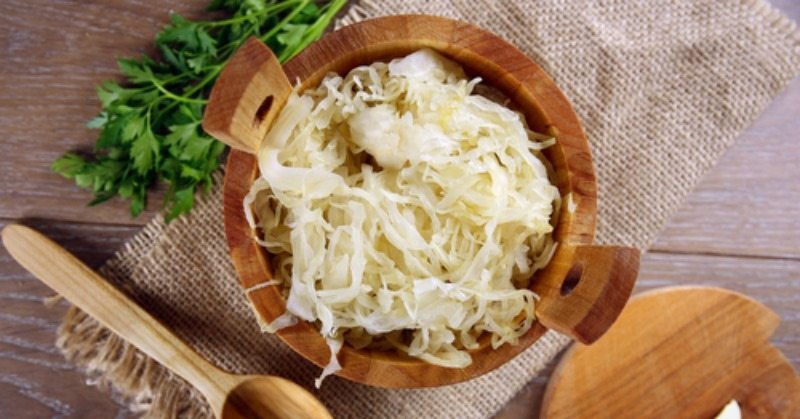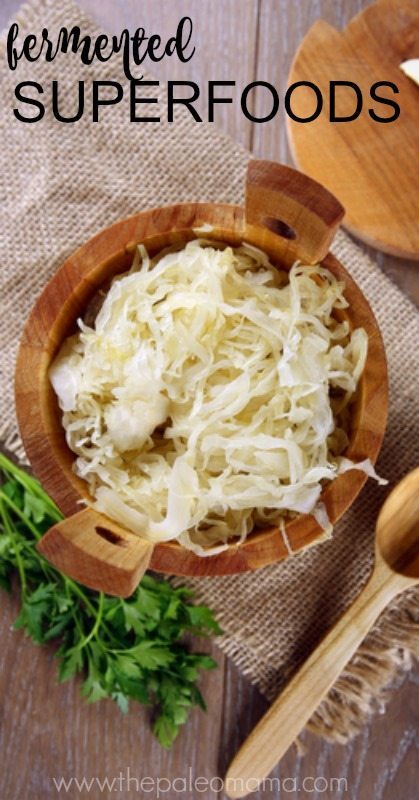
Whether shoppers are seeking gut health or go-for-it flavor, fermented foods and probiotics are growing like good bacteria—and they’re not just for hippies anymore. Probiotic foods have become more popular due to studies that show they can benefit both the digestive and immune systems, and fermented and pickled foods are at the top of the trend. Fermentation involves using a food’s naturally-occurring yeasts, bacteria, and other microbes to break it down. That’s how cabbage becomes sauerkraut, grapes become wine, and cucumbers become pickles.
Over the past year or so, I’ve blogged several times about fermented foods that I have tried—and loved. For example:
- My family loves our sourdough bread, cultured from a sourdough starter that is over 160 years old.
- I am a Kombucha addict. I love the taste, the smell, and the squishy scoby’s (fermented starter) that I use to make the drink.
- Our entire family sometimes simply pigs out on homemade sauerkraut (recipe here).
I want to take a closer look at the trend of fermented foods. If they’ve reached top dog status in health and wellness circles, then it’s time we learned a bit more about them.
Why Eat Fermented Foods?
Fermented foods have been used as medicine throughout history. Chinese workers ate acid-fermented vegetables while building the Great Wall of China. The Japanese have had Kimchi as part of their daily menu for centuries. The Romans used sauerkraut to treat and prevent intestinal infections. Captain Cook used sauerkraut and lime juice to prevent scurvy on his three-year journey around the world. Many African cultures use acid-fermentation to preserve gruels made from corn and sorghum.
It was once thought that the main purpose of fermentation and pickling was food preservation. People in my grandmother’s generation did a lot of it. I remember my mother talking about jars of sauerkraut in the cellar, and a crock of pickled pig’s feet (yes, yuck!) always available on the bottom shelf of the cupboard. But today we have recognized the danger of the unhealthy bacteria that is present in our bodies—and the health problems it can cause. Fermented foods are rich in good bacteria, and act as natural probiotics to support digestive health and balance bacteria in our bodies.
Fermented foods, as a group, are highly nutritious and digestible. Fermentation pre-digests foods, making nutrients more bioavailable, or easier for the body to absorb, and in many cases fermentation generates additional nutrients or removes anti-nutrients or toxins
—Sandor Katz, The Art of Fermentation
With more and more fermented food cropping up in the supermarkets and local farmers’ markets, let me suggest 5 good reasons why we should be eating more of them.
- You can’t digest your food alone. Good bacteria is what helps to break down what your body can’t do on its own.
- The good bacteria fight the bad—and usually win. We swallow disease-causing bacteria every day. But we don’t always get sick from it because the good bacteria in our body fights off the bad.
- Good bacteria helps your body produce many fat-soluble vitamins, including Vitamins B1, B2, B3, B5, B6, B12, and K.
- In order for your body to be healthy it needs balance between the bad bacteria that is problematic to your health, and the good bacteria that becomes the probiotic to allow the balance to set in.
- Good bacteria helps to restore your gut health after taking antibiotics. That’s a prime time for eating fermented foods because antibiotics destroy both the bad and good bacteria.[1]
Fermented food contain live cultures, which are tiny organisms in our intestines that help digest fiber, and protect us from carcinogens and other disease-related toxins.
What Are Some of the
Fermented Foods Available?
There are many different kinds of fermented foods available today. Many vegetables are great fermented, and it’s a great way to preserve your fresh harvest. Let me list 8 of the healthiest food and vegetables that you might want to try.
- Yogurt—this is the most consumed fermented dairy product in the United States today. But choose your yogurt carefully. Look for four things: it comes from goat or sheep milk, it’s grass-fed, it’s organic, and it doesn’t contain sugar. If you make your own (the best option), I recommend this yogurt culture.
- Sauerkraut—traditional sauerkraut is one of the best-known fermented foods. It is prepared from water, salt, and cabbage. Be sure to purchase raw sauerkraut, or make it yourself (recipe to follow below). I recommend this raw sauerkraut.
- Kombucha—made from tea, clean water, sugar, yeast and bacteria, Kombucha has become extremely popular in the last few years. After fermenting it becomes carbonated, and is a great substitute for the less-healthy soda you may consume. It is fun and easy to make yourself (see my blog) for the recipe I use to make it. I recommend this Kombucha culture scoby starter.
- Kefir—this is a fermented milk product (cow, goat, or sheep milk) and tastes just about like liquid yogurt. If you are choosing to drink kefir, make sure it’s organic and not loaded with sugar. If you make your own kefir, I recommend this kefir starter.
- Kimchi—you’ve probably tasted Kimchi at some point when you were eating Asian food. It is a spicy fermented cabbage, dating back to the 7th century. You can make your own Kimchi (recipe recommended).
- Pickles—we are all familiar with pickles. As a kid growing up, we knew there was always a huge jar of dill pickles in our refrigerator for snacking. When you buy pickles, choose a food manufacturer that uses organic products and ferments it the old fashion way.
- Miso—you’ve probably seen and even ate miso soup when you were eating oriental food. It is created by fermenting. Because it is made from soy, which in most American products is a GMO product, many avoid it altogether. But miso is made from fermented sources of soy, which yields a completely different set of nutrients. Stick to organically grown fermented soy products like miso, tempeh or natto.
- Raw Cheese—raw milk cheeses are made with milk that has not been pasteurized. Goat milk, sheep milk, or A2 cow’s milk (milk containing beta-casein, found only in Jersey, Asian and African cows) produce soft cheeses high in probiotics. These cheeses can include: Mozzarella, Havarti, Baby Swiss, Sharp Cheddar, Colby, and Pepper Jack. But NOTE: You won’t find them in the same aisle with sliced sandwich cheeses and pre-shredded cheese (with wood pulp). Look in the imported European cheeses counter. I make our own raw cheeses, using this mesophilic cheese culture.
Can I Make My Own Fermented Foods?
Absolutely! That’s one of my main reasons for writing this blog. I love it when we can keep up with the latest health and wellness trends by making our own products. There are many websites that can help you get started, including this one. I currently make several fermented foods, including sauerkraut, kombucha, sourdough bread, and my most recent love, Fire Cider. I want to share a couple of my recipes with you.
Kombucha
Kombucha is an ancient elixir that has a history of starting in China and, somehow, made its way over here to America. It is a sort of “tea” that is infused by fermentation with beneficial bacteria, probiotics, and yeast and is great for your gut and overall health. It is made from either using black or green tea, and some herbal teas, some sugar (which the yeast feeds on), and lots of patience.
Why do I drink it? Well, first of all, I’m cheap. I am a self-proclaimed cheapo and the cost of probiotics is just ridiculous. The cost to make a gallon of Kombucha is around $1! The cost to buy a 16 ounce bottle of Kombucha from a health food store is $4! The cost to buy a bottle of probiotics is $40! Hmmm, tough decision but I’ll stick with my cheap Kombucha!
You can find my easy, 6-step method for making Kombucha here.
Sauerkraut
I don’t think you can find better sauerkraut than that prepared by Germans for centuries before this. We have a German restaurant here in Asheville, North Carolina that serves the best sauerkraut I’ve ever tasted. But you can make your own, just as I do, by following an easy recipe passed down from Germany.
You will use shredded cabbage, juniper berries, caraway seeds, yellow mustard seeds, pickling salt, and filtered water. You can find the recipe, which is the one I use, here.
Eat Some Fermented Food Every Day
Fermented and cultured foods are a wonderful source of probiotic bacteria needed to support good health. Here are some simple ways you can add some to your menu every day.
Breakfast
Have some kefir to start your day.
Add some fermented salsa to your scrambled eggs.
Lunch
Enjoy some chopped pickles in your salad, tuna, or ham salad sandwiches.
Use fermented mayo instead of store-bought mayo.
Dinner
Make sauerkraut one of your evening side dishes.
Try making your own Italian dressing with kombucha.
Snacks
Have a slice of sourdough bread with some kefir dill spread.
Serve a kefir soft-serve ice cream for dessert.
So now you have some of the tools you need to get started adding fermented foods to your diet. Experiment with many, and do your own research to find the ones you like best. Most of all—GET STARTED!
To ferment your own food is to lodge a small but eloquent protest – on behalf of the senses and the microbes – against the homogenization of flavors and food experiences now rolling like a great, undifferentiated lawn across the globe.
—Michael Pollan

Sources
- https://www.drdavidwilliams.com/gut-health-and-the-benefits-of-traditional-fermented-foods/
- https://draxe.com/fermented-foods/
- https://www.globalhealingcenter.com/natural-health/the-9-best-fermented-foods-for-your-gut/
[1] https://www.everydayhealth.com/diet-nutrition/diet/reasons-eat-more-fermented-foods/
I enjoyed this article. Fermented superfoods are so important to our health. While I enjoy sauerkraut I never developed a taste for kimchee 🙂 I write about natural remedies that are based on science on my website. If you have the time, then take a look.
Keep up the good work!
Jonathan